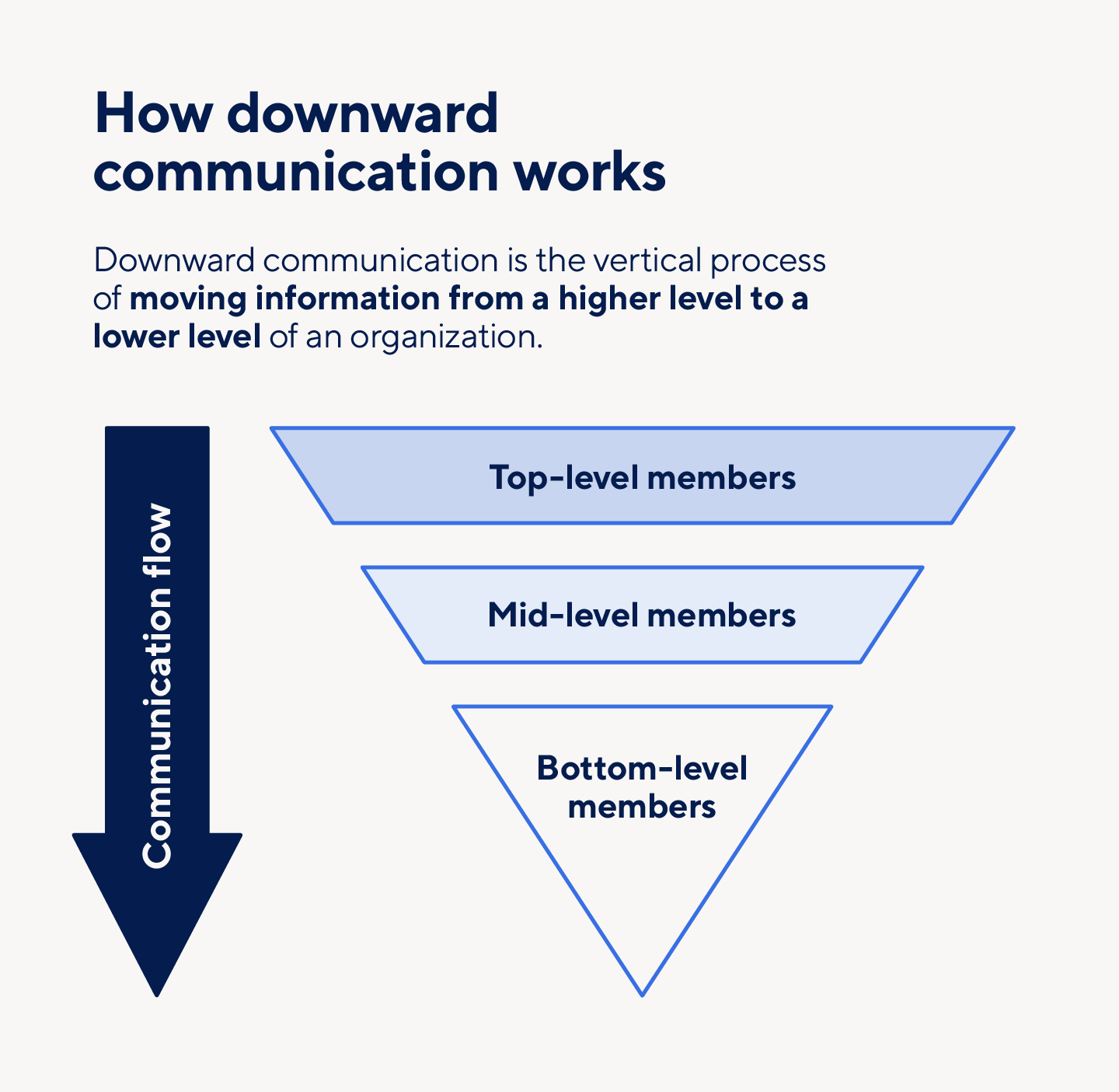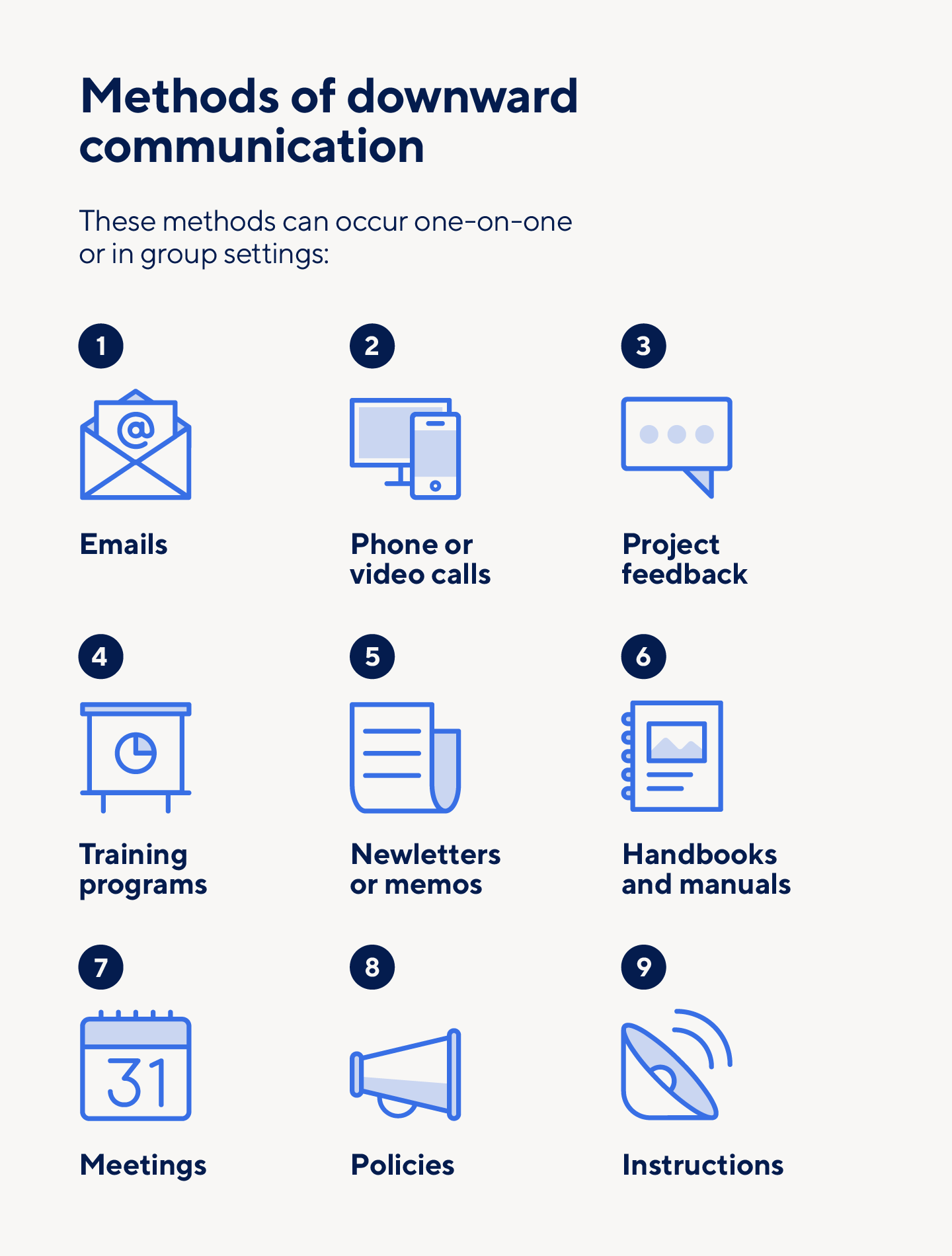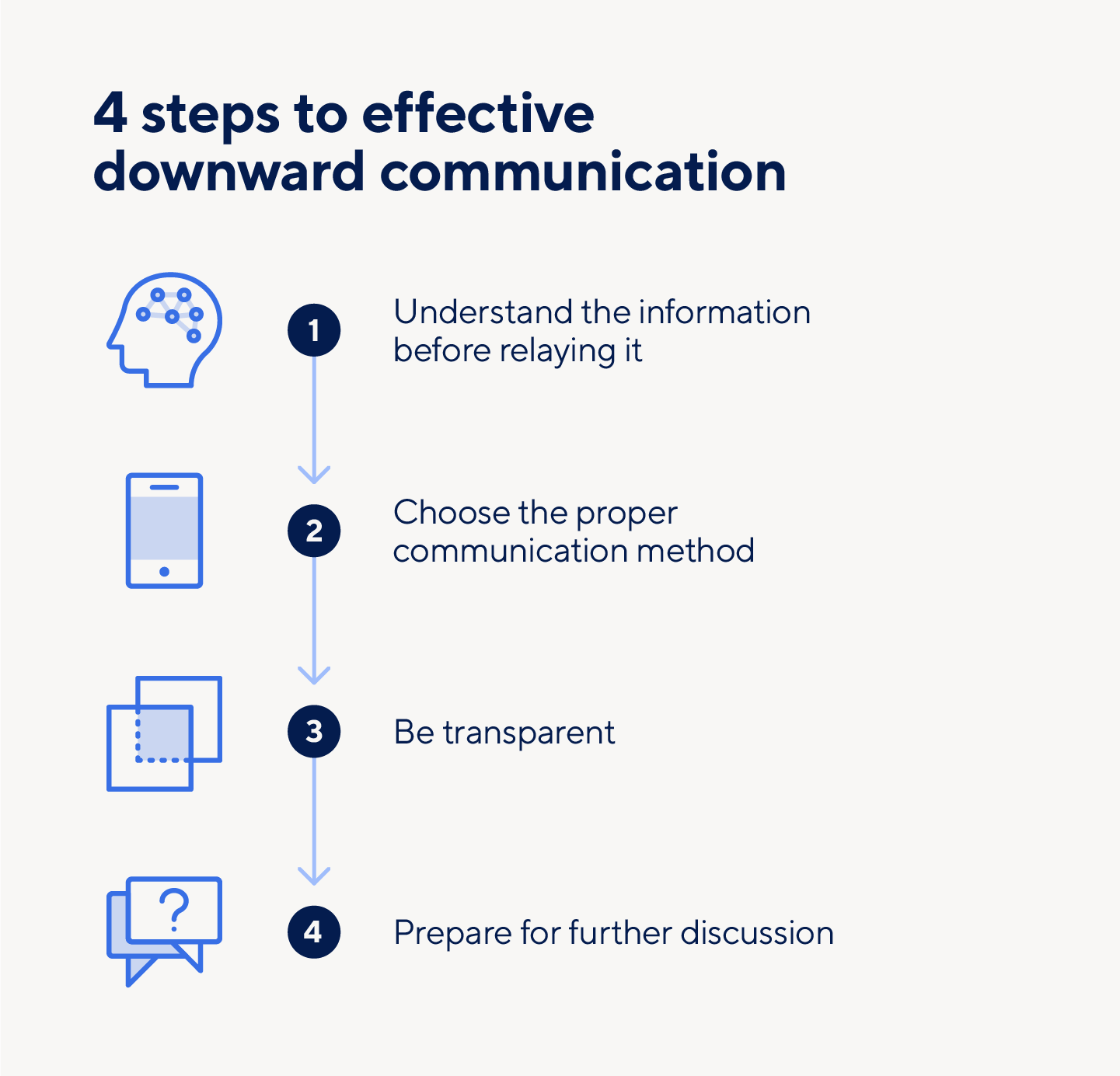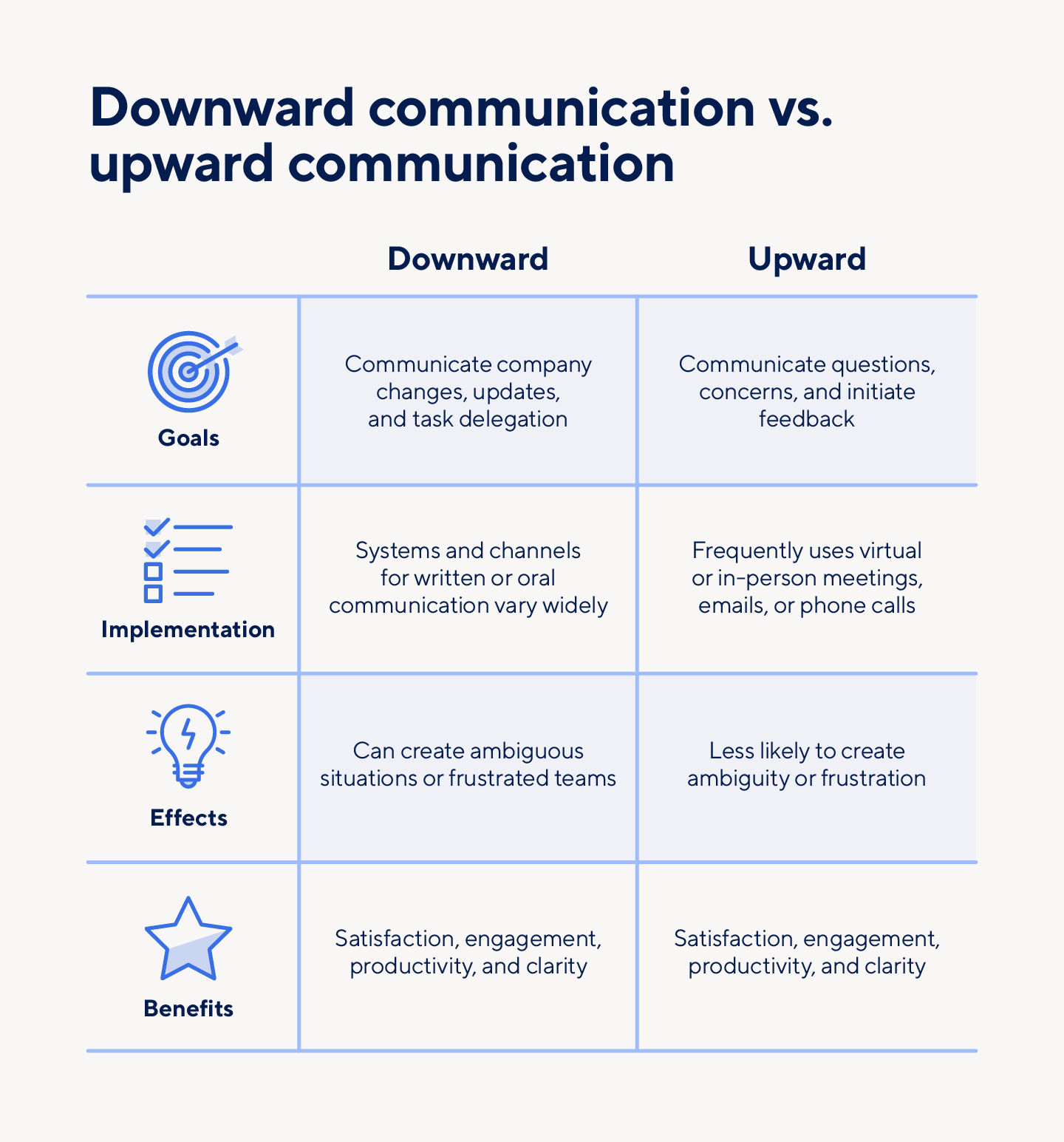What Is Downward Communication?
Downward communication, or top-down communication, occurs when upper management or high-level leaders communicate information to lower-level organization members. Companies use this vertical form of internal communication to relay policy and responsibility updates or changes within the organization overall.
Additionally, downward communication aims to:
- Convey information about internal strategies and policies.
- Help instruct and train employees on a company’s processes.
- Improve the morale of employees across the company.
While downward communication is usually one-directional, it should be possible for employees and managers — even those on remote teams — to ask questions or initiate discussions about the information received through top-down communication.
Types of Downward Communication
Downward communication is a necessary element of all organizational and team communication, but communication strategies may vary depending on the message and its recipients. There are four main categories of top-down communication:
- Manager to Employee: In perhaps the most common form of top-down communication, managers or supervisors convey information, instructions, and feedback to their direct reports.
- Senior Management to Lower Management: At the top of the management hierarchy, senior managers communicate with lower-level managers, who may relay this messaging down the chain of command to employees and other workers.
- Senior Management to Employees: Senior managers may communicate directly with lower-level team members to convey employee-specific messages or updates.
- Executive to Company: Company executives, like a board of directors, may choose to transmit messages to an entire organization simultaneously, or to communicate information to senior management or lower management.
Downward Communication Examples
Downward communication often involves face-to-face conversation, whether one-on-one or in a group setting, but there are many methods for distributing information from the top down. Here are examples of the main ways organizations transmit messages from higher-level management to employees:
- Emails: Managers may email an individual employee or a wider distribution list, either for a specific team or the entire company.
- Phone or Video Calls: Conference or individual calls are often the best way for managers to reach employees quickly and communicate sensitive or urgent information.
- Project Feedback: Whether written or verbal, clear and actionable feedback from management is essential to employee growth.
- Training Programs: Top-down training programs, from onboarding to more specialized technical skills training, offer employees support and professional development.
- Newsletters: Regular news bulletins and memos can strengthen company culture while distributing information to all areas of an organization.
- Handbooks and Manuals: Organizations may create physical documents or online resources that contain procedures, policies, and general information for employee reference.
- Meetings: In-person or virtual meetings offer a more formal and scheduled setting for management to communicate with their teams.
- Policies: Policy updates allow an organization to communicate changes to company guidelines, job expectations, and regulations to all employees.
- Instructions: Supervisors can transmit instructions for specific projects and tasks, as well as general updates to job requirements, via written, digital, or verbal communication with employees.
While these examples showcase common downward communication methods, organizations may use different strategies depending on the message that they need to communicate. Managers must determine which communication channel best fits the situation.
Effective Downward Communication: 4 Steps
There is no one-size-fits-all approach to effective downward communication. That said, organizations can incorporate several best practices into their plans to ensure their members understand and share information appropriately. Before conveying any type of message, communicators should take four important steps.
1. Understand Information Before Relaying It
Downward communicators must thoroughly understand their message before relaying any information. Unclear top-down communication causes employee frustration and lowers productivity and engagement. To guarantee information is clear and correct, communicators can review messages with lateral-level team members before sharing.
2. Choose Proper Communication Methods
Deciding which communication method fits the situation is as important as the information itself. Some messages may be written with verbal follow-through, while others require immediate face-to-face conversations. Depending on the announcement or message, employees may need a new-and-improved handbook or job description, an updated employee-only webpage or database, or regular team meetings.
3. Be Transparent
Clarity, consistency, and honesty are essential in all communication, especially downward communication. During complex policy changes, potential mergers, or other demanding situations, transparent communication tells employees they are trusted and valued, making them more likely to support organizational updates.
4. Prepare for Further Discussion
Finally, successful downward communication includes preparing for questions and requests for clarification from employees across all levels of the organization. Open lines of communication — immediately following an announcement or in future conversations — makes employees feel heard and respected.
Benefits of Downward Communication
Effective downward communication — when transmitted transparently and through the proper methods — enables organizations and employees to delegate tasks, work efficiently and productively, maintain consistent messaging, and support the chain of command. Here is a breakdown of these key benefits:
- Delegation: Downward communication helps managers and executives delegate tasks to employees efficiently and effectively. The project’s supervisors can directly convey the needs and expectations to an assigned individual.
- Productivity: With transparent internal communication comes increased productivity — workers understand their role expectations, and they are more likely to successfully complete tasks when they are aware of their responsibilities, deadlines, and goals.
- Efficiency: Clear and direct instructions, expectations, and direct feedback from managers helps employees understand their jobs and perform tasks immediately.
- Consistency: When executives communicate directly to the entire organization or team, there is a single, consistent source of information. Direct downward communication does not use a mediator, so employees hear a consistent message from the top of the company.
- Hierarchy Maintenance: Top-down communication helps maintain hierarchy structures and reassure individuals about the value of their specific roles within an organization.
Challenges of Downward Communication:
Downward communication in an organization is effective, but it’s usually not perfect. Organizations must consider the challenges of top-down communication — including delays, employee frustration, and potential misunderstandings — in order to avoid them. Here are four internal challenges of downward communication:
- Delays: Downward communication can take time, especially if a message needs to pass through multiple levels before reaching its intended recipient. When feedback moves through the hierarchy ladder slowly, it can disrupt productivity.
- Employee Frustration: Some employees may see forms of hierarchical communication as micromanagement. In democratic organizations, downward communication can feel demeaning, leaving employees frustrated that they weren’t included in the development of the messaging.
- Devalued Individuals: Ineffective top-down communication can devalue individuals by ignoring their professional expertise and leaving little room for further discussion. Broken forms of downward communication can make employees doubt their importance to the organization.
- Misunderstandings: Messages starting at the top of a hierarchical structure might be misinterpreted and misunderstood by lower-level employees. Written communication can help individuals correctly relay information, but downward communication can still lead to confusion.
Upward and Downward Communication: The Difference
Top-down and bottom-up communication are both integral parts of an organization’s internal communication strategy. Upward communication is the opposite of downward communication — employees communicate questions, concerns, ideas, and other messages up the organizational hierarchy.
While upward and downward communication work together to form a company’s internal communication system, each has its own goals, implementation practices, and benefits. Organizations must understand these vital differences to use each communication style effectively:
- Top-Down Goals: Organizational changes, updates, and delegations of projects and other assignments are best communicated from the top down.
- Bottom-Up Goals: Upward communication gives lower-level employees the opportunity to ask questions, share concerns, or request feedback from higher-level managers.
- Top-Down Implementation: Downward communication has many uses, so its implementation systems vary widely. These can include written or oral communication, employee handbooks or other reference materials, and company-wide or team meetings.
- Bottom-Up Implementation: Upward communication most frequently takes place through in-person or virtual conversations, emails, or phone calls.
- Top-Down Effects: Downward communication needs to be clear and concise so that companies can provide important guidance, feedback, and information. Unclear communication from management can produce confusion, ambiguity, and frustration for employees.
- Bottom-Up Effects: Clear upward communication helps employees get the answers they need. To do so, they must have opportunities and support to communicate with management effectively.
- Top-Down Benefits: Effective downward communication leads to increased team satisfaction, engagement, productivity, and clarity.
- Bottom-Up Benefits: Like top-down communication, successful upward communication increases an employee’s understanding of their role and feelings of value, satisfaction, and engagement.
Wrapping Up: The Importance of Company Messaging and Downward Communication
Empower your people to go above and beyond with a flexible platform designed to match the needs of your team — and adapt as those needs change.
The Smartsheet platform makes it easy to plan, capture, manage, and report on work from anywhere, helping your team be more effective and get more done. Report on key metrics and get real-time visibility into work as it happens with roll-up reports, dashboards, and automated workflows built to keep your team connected and informed.
When teams have clarity into the work getting done, there’s no telling how much more they can accomplish in the same amount of time. Try Smartsheet for free, today.



